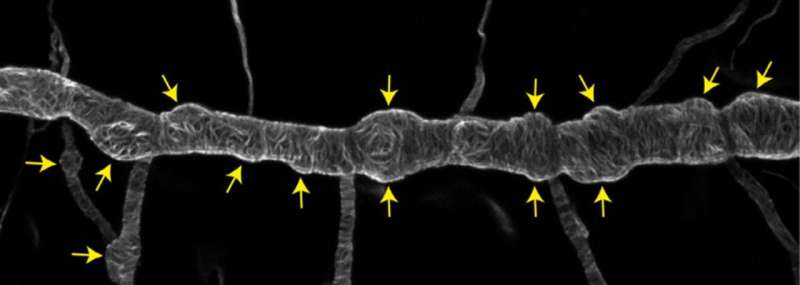This article has been reviewed according to Science X's editorial process and policies. Editors have highlighted the following attributes while ensuring the content's credibility:
fact-checked
peer-reviewed publication
trusted source
proofread
Defect in fruit fly respiratory system may provide insights into human aortic aneurysms

A team of researchers led by Leipzig University has gained new insights into the respiratory system of fruit flies—the so-called tracheal system—which could be important for future research into aneurysms. Dr. Matthias Behr from the Institute of Biology (Department of Cell Biology) at Leipzig University and his team, together with colleagues from the Max Planck Institute for Multidisciplinary Sciences in Göttingen, carried out genetic, cell biological and biochemical studies on Drosophila embryos.
They found that the cells in the fruit fly's tracheal system are connected to the extracellular matrix by the proteins Dumpy and Piopio. They have just published their research findings in the journal eLife.
Similar to the human circulatory system or lungs, the fruit fly's tracheal system consists of a network of tubes. During the embryonic development of these insects, this network of tubes is filled with a special substance secreted by the surrounding cells that gives them shape (an extracellular matrix). As the organs grow, the cells are closely connected to this extracellular matrix and "shimmy" along it to form the right shape and size of tubes.
The forces between the cells and the extracellular matrix shift during this time, for example due to strong cell growth. This could lead to deformation of the cell membranes because the overlying matrix cannot expand with them. When this happens, the protease Notopleural comes into play. This is an enzyme that cleaves proteins or peptides. The enzyme acts like a pair of scissors, cutting up the Piopio protein and breaking the cell-matrix bonds.
"This trick avoids excessive tension and deformation of the cell membranes. If this does not happen, bumps and cracks form in the tube system and the fruit fly's respiratory system does not function," says Behr, senior author of the study.
He explains that similar defects occur in the human circulatory system in the form of aortic aneurysms. Since the proteins that Behr and his colleagues have identified in their study of the fruit fly are also present in very similar form in humans, the mechanism described could support future research into the cause of aortic aneurysms and similar tubular diseases.
More information: Leonard Drees et al, The proteolysis of ZP proteins is essential to control cell membrane structure and integrity of developing tracheal tubes in Drosophila, eLife (2023). DOI: 10.7554/eLife.91079
Journal information: eLife
Provided by Leipzig University





















